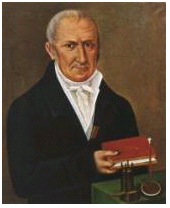Dead Electrical Dudes – No. 6
This Month’s Stiff: Count Alessandro Giuseppe Antonio Anastasio Volta (whew!)
Entered Mortal coil: 8 February 1745
Assumed Room Temperature: 5 March 1827
“Signore Artist, How long must I hold up this book?”
I look upon these old posed portraits with skepticism. By that, how long did Mr. Volta have to hold that book for this painting? Perhaps Volta’s friend and contemporary, Mr. Luigi Galvani, b.k.a. The Frog Torturer, would have gladly offered to shock his biceps to help with those nasty muscle cramps. Anyway, I digress…
Every time you fumble around in the dark during a power outage, cursing because the flashlight doesn’t work, or are stranded because the darn car won’t crank, or lose all the memories and/or operating parameters in your HF radio’s volatile memory, or you are simply caught flat-footed on Christmas morning as your child cries because his new Super Destructor Evil Doom Machine is only a piece of inanimate plastic, its all because we have come to rely on a relatively ubiquitous piece of technology referred to technically as the voltaic cell. But, almost 200 years ago, this invention literally and figuratively shocked the scientific world (I apologize, this was too hard to resist!).
Signore Volta was born of nobility. At the age of only 14, young Alessandro set his life’s course when he decided his career would be in the field of physics, with an emphasis on electricity. By 1778, the young scientist had isolated methane in the laboratory. He should have visited a nearby cow pasture, in my opinion, for fresh samples of the gas! Volta also invented a static charge accumulator which is the basis of modern capacitors. Such was Alessandro’s success in his endeavors that he was awarded the Copley Medal by the Royal Society in 1791. Greater things and discoveries, however, were to come.
Back to Luigi Galvani: Volta’s friend had been experimenting with the phenomena of what he termed “animal electricity”. Galvani had inserted electrodes of differing metals into a frog’s legs, which resulted in muscular contractions (in essence, the “frog juice” was an electrolyte). Luigi thought he was providing a path for the natural animal electricity.
Volta read and discussed his friend’s findings, disagreed with Luigi good-naturedly, and investigated further. Volta removed the frog, used alternating discs of copper and zinc, and inserted absorbent cardboard pads between the discs which were impregnated with a suitable solution of salts or acid. In 1800, he stacked many of these discs together, a “battery” of them, so to speak, and was greeted with success. The potential generated by only 20 of these discs was enough to inflict pain.
Napoleon Bonaparte requested a “command performance” of Alessandro in 1801 for a personal demonstration of the device. So impressed was the potentate with the “pile of discs” that Volta was eventually made a Count. This invention is also referred to as the voltaic pile.
For Volta’s work, the unit of electromotive force, the VOLT, designated by either the symbols “E” or “V”, was named after him.
Philip Neidlinger, P.E. KA4KOE
